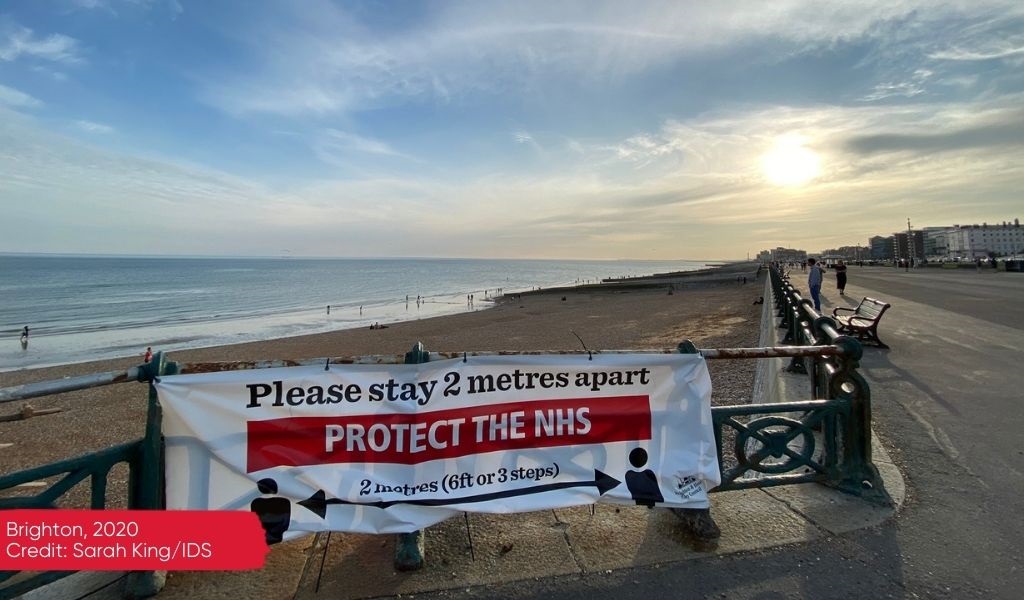In June, I travelled from Brighton to Madrid to visit my family for the first time in 18 months, allowing me to experience pandemic life in a different context. I was struck by how many social science aspects of the pandemic the two cities share, as well as by the differences between them, and how these relate to the lessons learned from previous pandemics.
The COVID-19 waves have been similar in terms of their timing, with an initial peak in April-May and two subsequent waves – one preceding Christmas and the other immediately after. However, there was a large divergence in the size of those peaks between the two countries. The first wave hit Spain the hardest (1.84 average deaths per 100,000) and the UK was not far behind. In both Madrid and Brighton, everyone was confined to their homes, only leaving to buy essentials or go to the doctor (and, in the UK, to do exercise).
The second wave was similar in size in both countries, but in Spain it was followed by a significant decrease in cases, whereas in the UK it overlapped with a third wave (1.87 average deaths per 100,000). In the UK, this massive post-Christmas peak has been attributed to the emergence of the Alpha variant (originating in Kent) and delays in imposing lockdowns over Christmas. In Spain, the post-Christmas peak was significantly more moderate, and cases slowly decreased.
Whilst in Brighton during the winter of 2020 I could only see one friend at a time whilst exercising outdoors, Madridians visited restaurants, bars, and cinemas indoors (although socially distanced in groups of six, with a curfew) and managed to contain the second and third waves with a minimised version of ‘normality’.
However, the vaccination programme kickstarted in the UK, earlier than in the rest of Europe, there has been a shift and is expected to keep hospitalisations and mortality rates down. Spain started with some difficulties, and is slowly catching up, with people in Madrid in their 40s receiving their first jab as I write this.
The parallels and differences between Madrid and Brighton however, highlight the importance of integration of social science knowledge into pandemic responses:
- People feel a sense of responsibility and expect the same from others: In both Spain and the UK, people reacted to COVID-19 earlier than their governments, cancelling their participation in or hosting of mass activities even before the first lockdown. One can expect public collaboration, rather than looting and chaos seen in movies like Contagion. This is achieved when the response engages with people transparently. While the UK and Spanish governments showed ineptitude and lack of preparation at the onset of the epidemic, public communication was good enough to sustain citizen cooperation. Unlike in the UK, people in Spain have had to wear masks in outdoor public spaces (until the 26th June) and must continue to wear them indoors. If you don’t, someone will point it out or give you a dirty look. Rather than driven by fear, it is driven by a sense of obligation.
- Britain’s indoor/outdoor is Spain’s mask/no mask: When I ask family and friends in Madrid whether things are happening outdoors or indoors, the question does not resonate. People in Madrid visit each other’s homes but keep their masks on. Last week, I visited my cousin, aunt and niece in Madrid, and we chatted for over an hour with our masks on, occasionally lifting them up to sip beer or eat crisps. I struggle to imagine this happening in Brighton, where people would either not visit indoors, or would ‘take the risk’ and visit someone indoors without a mask. I wonder how much this is driven by the British fear of offending.
- Politics plays a key role: As is common in epidemics, the response is layered over a pre-existing political economy. In the UK, the Conservative government centralised the response, despite local pressures from northern Labour regions advocating for a more bottom-up, tailored approach. In Madrid, right-wing parties in regional and local governments have gainfully politicised the pandemic in their struggle against Pedro Sanchez’s centre-left government. Right-wing populist Mayor Ayuso portrayed the stricter lockdown measures recommended by the government as oppressive and dictatorial, and won the election on the slogan “Communism or Freedom”. However, in reality, regional governments have had the mandate to decide the intensity of their measures.
- COVID-19 exacerbates inequalities: Not all Madridians and Brightonians are affected equally by the epidemic and response. Many people, particularly those from working class backgrounds, could not work remotely, depended on public transport, and were more likely to live in overcrowded accommodation. Infection rates have been significantly higher in working class neighbourhoods in both Madrid and Brighton, and people in these areas were more likely to have comorbidities that increased chances of hospitalisation or even death. In Madrid, Mayor Ayuso exacerbated inequalities by creating neighbourhood-level movement bans, disproportionately affecting working class neighbourhoods. The expectation is that these same neighbourhoods will be worse affected by the economic downturn following the pandemic.
- Vaccine hesitancy is not the same as vaccine avoidance: People in Madrid are very attuned to the different types of vaccines. Due to the communication fiascos about the vaccine risk for over-60s, the German and French governments leaning in, and the rare emergence of clots, AstraZeneca is considered a second-class vaccine. That said, as is also common with vaccination programmes, vaccine hesitancy has not translated into vaccine refusal, and most Madridians are seeking their jabs, regardless of brand. People in Brighton seem less concerned about what vaccine they receive and are equally keen to get it, although young people are relieved to not be offered AstraZeneca. Getting an online vaccine appointment in Brighton was as competitive as buying Glastonbury tickets!
- UK residents were relatively more concerned about variants until the Delta variant: The spread of different variants makes the news more often in Britain. It is not surprising, since the government attributed the third wave to the Alpha variant, rather than their delay in imposing a lockdown. The spread of the Alpha variant in Spain, was in the range of 70-92 percent of all COVID cases in June, and did not spark a rise in hospitalisations or deaths. Originally the Delta variant was a matter of concern for the UK and not Spain. The population of people of Indian descent is significantly higher in the UK than in Madrid, shaping both the exposure to the Delta variant, and increased UK news coverage of the heart-breaking tragedy that unfolded in India in May. In recent days, the Delta variant is in everyone’s minds, spreading like wildfire in Brighton and Madrid amongst the younger cohorts. Restaurants are having to close, and schoolchildren are being sent home to self-isolate in Brighton. Luckily, there is evidence of a delinking of cases with hospitalisation and deaths due to vaccination.
There are so many other things I could highlight, but I think this gives a flavour of the differences between these two cities and highlights how epidemics are inevitably intertwined with their local contexts and how these relate to the COVID-19 response. People in my two hometowns, Brighton and Madrid, are concerned about the recent dramatic rise in cases, yet with the roll-out of the vaccine programme, they are starting to feel hope for the future. I do too.
This blog post is one of a series, providing insights and reflections from the SSHAP ‘Social Science and Epidemics’ collection. The collection reviews different aspects of past disease outbreaks to identify social science ‘entry points’ for emergency interventions and preparedness activities.




